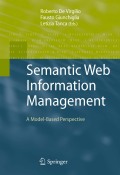
Semantic web information management: a model-based perspective
Virgilio, Roberto de
Giunchiglia, Fausto
Tanca, Letizia
Databases have been designed to store large volumes of data and to provide efficient query interfaces. Semantic Web formats are geared towards capturing domain knowledge, interlinking annotations, and offering a high-level, machine-processable view of information. However, the gigantic amount of such useful information makes efficient management of it increasingly difficult, underminingthe possibility of transforming it into useful knowledge. The research presented by De Virgilio, Giunchiglia and Tanca tries to bridge the two worlds in order to leverage the efficiency and scalability of database-oriented technologies to support an ontological high-level view of data and metadata. The contributions present and analyze techniques for semantic information management, by taking advantage of the synergies between the logical basis of the Semantic Web and the logical foundations of data management. The book’s leitmotif is to propose models and methods especially tailored to represent and manage data that is appropriately structured for easier machine processing on the Web. After two introductory chapters on data management and the Semantic Web in general, the remaining contributions are grouped into five parts on Semantic Web Data Storage, Reasoning in the Semantic Web, Semantic Web Data Querying, Semantic Web Applications, and Engineering Semantic Web Systems. The handbook-like presentation makes this volume an important reference on current work and a source of inspiration for future development, targeting academic and industrial researchers as well as graduate students in Semantic Web technologies or database design. INDICE: Introduction - Data and Metadata Management - Semantic Web Languages.- Part I: Semantic Web Data Storage.- Relational Technologies, Metadata andRDF - A Metamodel Approach to Semantic Web Data Management - Managing Terabytes of Web Semantics Data.- Part II: Reasoning in the Semantic Web.- Reasoning in Semantic Web-Based Systems - Modular Knowledge Representation and Reasoningin the Semantic Web - Semantic Matching with S-Match - Preserving Semantics in Automatically Created Ontology Alignments - tOWL: Integrating Time in OWL.- Part III: Semantic Web Data Querying.- Datalog Extensions for Tractable Query Answering over Ontologies - On the Semantics of SPARQL - Labeling RDF Graphs for Linear Time and Space Querying - SPARQLog: SPARQL with Rules and Quantification - SP2Bench: A SPARQL Performance Benchmark.- Part IV: Semantic Web Applications.- Using OWL in Data Integration - Service Knowledge Spaces for SemanticCollaboration in Web-Based Systems - Informative top-k Retrieval for AdvancedSkill Management.- Part V: Engineering Semantic Web Systems.- MIDST: Interoperability for Semantic Annotations - Virtuoso: RDF Support in a Native RDBMS - Hera: Engineering Web Applications Using Semantic Web-Based Models.- Index.
- ISBN: 978-3-642-04328-4
- Editorial: Springer
- Encuadernacion: Cartoné
- Páginas: 500
- Fecha Publicación: 02/12/2009
- Nº Volúmenes: 1
- Idioma: Inglés
